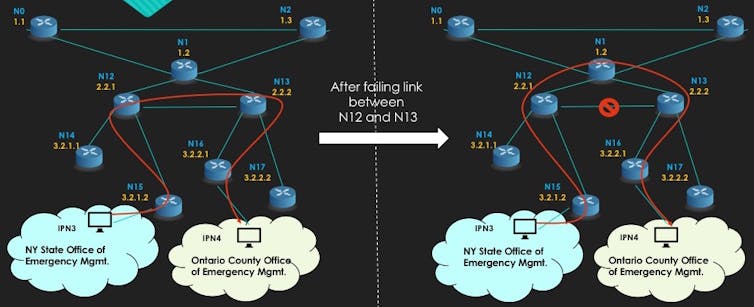
Right through massive screw ups, like hurricanes, wildfires and terrorist assaults, folks need emergency responders to reach temporarily and assist folks handle the disaster. So as to do their easiest, police, medics, firefighters and those that arrange them want numerous knowledge: Who’s positioned the place, wanting what assist? And what apparatus and which rescuers are to be had to intrude? With the entire era we now have, it will appear that accumulating and sharing numerous knowledge can be beautiful easy. However speaking thru a crisis is a lot more difficult than it seems that.
The development itself could make communications worse, destructive networks and speak to methods or reducing electrical energy to a space. And common folks regularly upload to the issue as they overload cell networks with calls, texts and different digital messages checking on family members or in the hunt for assist.
As researchers about virtual networks and emergency communications, we’re growing a quicker and extra dependable strategy to ship and obtain massive quantities of information in the course of the cyber web in occasions of disaster. Operating with precise responders and emergency managers, we now have created a technique for giving pressing knowledge precedence over different cyber web visitors, successfully making a high-speed lane on the web to be used in emergencies. Whilst a countrywide emergency responder community initiative referred to as FirstNet is starting to get going, it calls for construction an all-new wi-fi community only for emergency services and products to make use of. In contrast, our gadget makes use of present cyber web connections, whilst giving precedence to rescue employees’ information.
Connecting networks
Nowadays, it’s relatively not unusual for conversation networks to change into overloaded when crisis moves. When a lot of people attempt to make mobile phone calls or use cell information, the networks get too busy for calls to glue and messages to move thru.
The issue is that normal strategies for routing visitors in the course of the cyber web aren’t all the time ready to deal with all the ones connections at one time. In technical phrases, the cyber web is a selection of greater than 54,000 smaller networks. One of the vital networks that make up the cyber web are moderately massive, like the ones belonging to primary cyber web carrier suppliers or massive companies, however lots of them are relatively small. Regardless of their measurement, each and every of those networks has apparatus that we could it path visitors to each and every of the others.
Laptop networks don’t all attach at once to one another. And their virtual addresses don’t assist a lot – we people think 12 Primary Side road and 14 Primary Side road are subsequent door, however computer systems with identical numeric addresses is probably not bodily neighbors to one another.
Because of this, the router connecting each and every of those 54,000 networks to the remainder of the cyber web should stay an inventory of each and every one among its opposite numbers, and the most productive manner to achieve each and every of them. That is like wanting an inventory of written instructions for each and every position on the planet chances are you’ll wish to move.
The program, ruled through the principles set out within the “border gateway protocol,” works neatly as a rule. But if it fails, there can also be lengthy delays in communications. In truth, on moderate, 150 seconds (two and a part mins) can move through earlier than a failure is recognized. In that point, the knowledge simply wait in a knowledge visitors jam, now not transferring. On-line, milliseconds subject – loads of seconds are successfully an eternity.
When one router detects a community failure, it has to let all of the others know what’s took place, and tips on how to reroute their visitors. That is like having only one visitors cop attempt to coordinate rush hour round a big bottleneck. The method takes a minimum of a number of mins, and infrequently a number of hours. Till then, information in transit can also be not on time or misplaced solely. In an emergency, that might imply the variation between lifestyles and demise.

Rochester Institute of Generation, CC BY-ND
Growing the emergency protocol
Operating with scholars from Rochester Institute of Generation’s Golisano School of Computing and Knowledge Sciences, we now have created a brand new visitors regulate gadget adapted in particular to emergency reaction networks. It runs with out affecting different protocols on the web. We name it the multi-node label routing protocol.
Slightly than requiring each and every router to stay observe of the most efficient instructions to each and every different one, we divide conceivable routes for cyber web visitors into hierarchies. Those reflect present emergency reaction plans: A person responder sends knowledge to a neighborhood commander, who combines a number of responders’ information and passes the knowledge directly to regional managers, who collect a much broader image they cross directly to state or federal reaction coordinators.
Our routing plan makes direct community connections reflect this real-world emergency reaction hierarchy. When routers are allowed to glue handiest with their rapid neighbors within the hierarchy, they may be able to understand when hyperlinks fail and reroute visitors a lot more temporarily.
Checking out in the actual international
Our gadget is designed to function over the similar cyber web as everybody else, and with out affecting different visitors. We examined our gadget at the Nationwide Science Basis’s World Atmosphere for Community Inventions, a collaborative effort amongst many universities across the U.S. that permits researchers to broaden networking protocols and methods the use of genuine computer systems and networking apparatus positioned around the nation. In our case, we hooked up 27 computer systems in combination for our checks, devised through
RIT environmental, well being and protection scholars, lots of whom are volunteer emergency responders.
Our take a look at – which we did in entrance of genuine emergency commanders and staff – in comparison our gadget to the usual border gateway protocol. After we broke hyperlinks within the 27-node community, multi-node label routing communications resumed inside 12.5 seconds, which is 12 occasions quicker than the common border gateway protocol’s restoration pace. We will shorten that extend much more through converting settings in our protocol’s configuration.
Our gadget can simply be put in throughout a much broader space than simply 27 take a look at machines, in particular as a result of the way it simplifies the trails knowledge takes between routers. This implies incident commanders and executives get knowledge extra temporarily, and are higher ready to allocate responders and gear to satisfy wishes as they broaden. On this manner, our paintings helps the efforts of those that enhance us in our hour of want.
Supply Via https://theconversation.com/creating-a-high-speed-internet-lane-for-emergency-situations-79151






